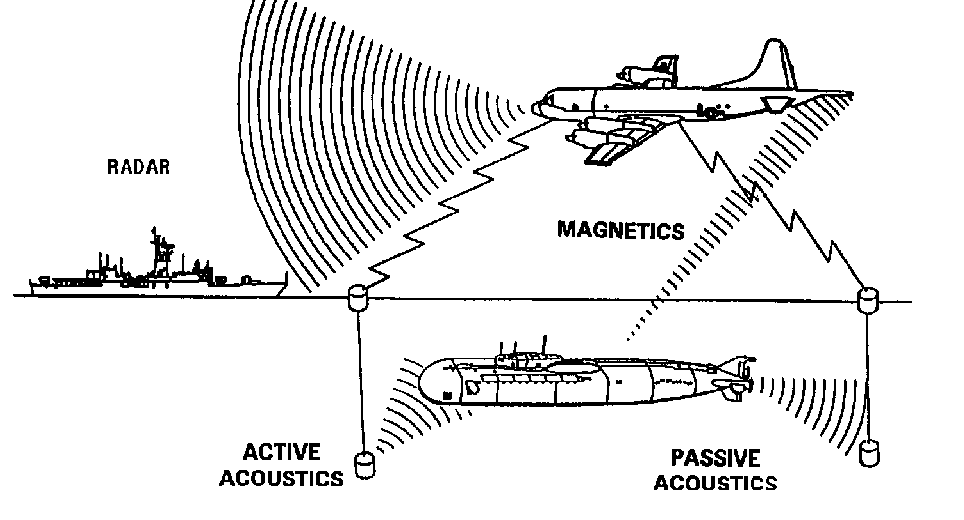The LIght Detection And Ranging (LIDAR) concept - a rough representation. (diagram courtesy of http://www.seos-project.eu/modules/laser-rs/laser-rs-c07-s01-p01.html )
---------
LIDAR could be used with other sensors, eg. magnetic and acoustic.
---------
As part of this websites exploration of anti-submarine technologies the following is a tiny part of:
Birkeland, John Olav (November 2009) The potential of LIDAR as an antisubmarine warfare sensor. University of Glasgow, Master of Philosophy (Research) thesis
LIDAR is short for LIght Detection And Ranging
Only quoting the thesis Abstract (from http://theses.gla.ac.uk/1252/ ):
Abstract
Traditionally, antisubmarine warfare (ASW) has been dominated by acoustic sensors, active and passive. Ending the Cold War, the ASW forces have refocused towards a theatre of war in the littorals, and the traditional acoustic sensors do not perform very well in such an environment. The sensors are working much closer to the surface, and there is a lot more surface traffic to disturb the acoustic environment. Environmental and topographic factors also play a major role. Removing or significantly reducing the acoustic capability, one forces the ASW forces to look to other technologies and sensors to compliment or replace the acoustic ones. This is where the interest of LIDAR as an aerial ASW sensor comes into play. The aim of this thesis is to evaluate “the potential for using LIDAR technology for aerial ASW on Norwegian ASW platforms”. In addition to this main research question, the history of LIDAR has been researched, in order to find historical and existing LIDAR projects for ASW purposes.
Antisubmarine warfare is a complicated business, but speed of reaction, flexibility to change operating areas quickly and efficiently, and the ability to deploy sophisticated buoys are all in the advantage to the aerial ASW platform. But as the submarines get quieter and quieter, new means of detection must be found to cover the complicated upper layers of the water column.
The signal components of LIDAR and the increasing processing capability have made LIDAR technology somewhat mature, but limitations such as scattering and attenuation of light in water are severely hampering.
After a decline in ASW focus after the Cold War, the Western world is finding itself in a littoral submarine threat scenario, and do not have the sensors to sufficiently meet this threat. Several LIDAR programs have been initiated and carried through, but most have been directed towards finding and neutralizing mines. Lately, a new interest of applying LIDAR-technology in the search for submarines has risen. But LIDAR itself does not seem to be able to cover the upper layers of the water column consistently enough, and other technologies might be able to compliment LIDAR in a multi-sensor solution. Synthetic Aperture Radar (SAR) and Hyperspectral Imagery seem to be the most applicable of these. A recommendation is given to military commanders to pursue a multi-sensor pod for several areas of use by Maritime Patrol Aircraft and military helicopters.
See complete thesis at http://theses.gla.ac.uk/1252/1/2009birkelandmphil.pdf
PETE'S COMMENT
Link with the following on this "gentleseas" website
PETE'S COMMENT
Link with the following on this "gentleseas" website
The DASH Program anti-submarine sensors - TRAPS & SHARK, April 8, 2013, http://gentleseas.blogspot.com.au/2013/04/the-dash-program-anti-submarine-sensors.html
Anti Submarine Drone Ship (ACTUV), March 18, 2013, http://gentleseas.blogspot.com.au/2013/03/anti-submarine-drone-ship-actuv.html , and
Satellite Detection of Submarines. April 11, 2012, http://gentleseas.blogspot.com.au/2012/08/satellite-detection-of-submarines.html
-
Pete

